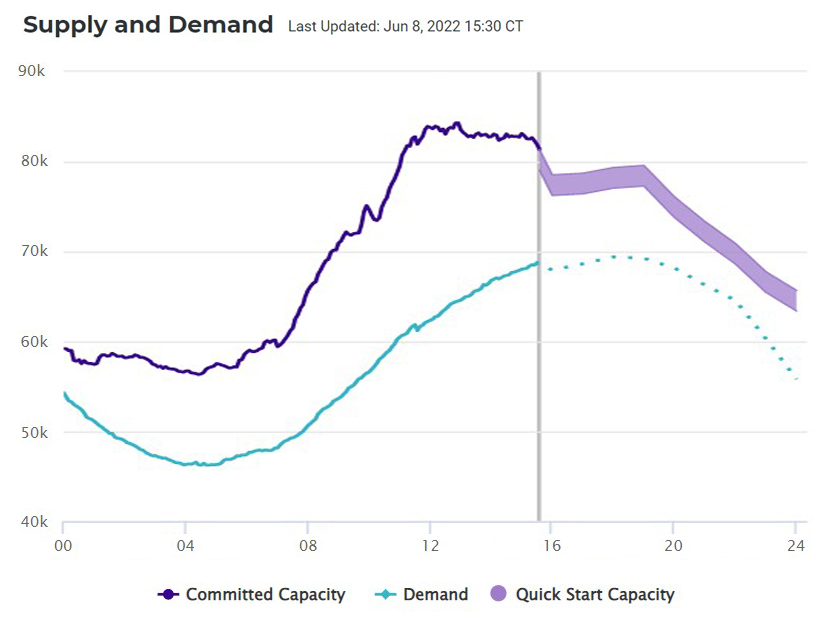ERCOT on Wednesday issued its third operating condition notice (OCN) since April, warning of extreme heat in several of its weather zones this weekend.
The Texas gird operator distributed the OCN, its lowest-level communication of a possible emergency condition, because it expects forecasted temperatures to exceed 103 degrees Fahrenheit in its North Central and South Central weather zones from Friday through Monday. Emergency conditions are issued when staff determine the system’s safety or reliability is compromised or threatened.
The first OCN was issued on May 3 and extended several times through May 20. A second OCN was issued for May 28-30.
AccuWeather said Wednesday Texans can expect the sweltering heat that has hung over the state since early June will stick around into next week. The weather pattern has been stuck in place for more than a week, the weather service said, allowing heat to build across the south-central U.S.
Daily temperatures have been 5-15 degrees above normal in many cities, with San Antonio setting records with consecutive 104-degree days Monday and Tuesday. Temperatures in the Dallas area are expected to reach triple digits Friday for the first time this year; the average date for Dallas’ first 100-degree day is July 1, according to an AccuWeather meteorologist.
ERCOT this week expected to break its all-time peak demand record of 74.8 GW, set in August 2019. (See ERCOT Expecting Record Demand this Week.) Demand fell short of that mark but did set June highs of 72.4 GW and 72.8 GW Monday and Tuesday, respectively. Demand Tuesday stayed above 72 GW for the three intervals ending 4-6 p.m.
The day-ahead forecast for Thursday projects a demand peak of 75.6 GW.
The ISO’s conservative operations posture had as much as 84 GW of committed capacity available Wednesday, when demand was expected to barely reach 70 GW. ERCOT apparently reduced demand by 649 MW after an explosion shut down an LNG plant near Houston.
In a blast email response to a Dallas television station that was sent to ERCOT’s media distribution list Wednesday, the grid operator said it “projects sufficient generation to meet forecasted demand.”
ERCOT expects peak demand to hit a record 77.3 GW this summer, it said in its seasonal assessment of resource adequacy released last month.
TAC Briefed on Recent Frequency Event
Staff gave ERCOT’s Technical Advisory Committee an early update on a frequency event last weekend in West Texas that momentarily knocked 2.5 GW of capacity offline.
Woody Rickerson, the ISO’s vice president of system planning and weatherization, told the committee during a Tuesday webinar that a lightning arrestor on a 345-kV line near Odessa faulted. Voltage briefly fell to 59.706 Hz before being restored to 60 Hz within two minutes.
The outage took 1.7 GW from 14 solar sites offline. Eight of the 14 solar sites also tripped offline last year in what is now called the “Odessa disturbance.” More than 1.1 GW of solar PV resources, up to 200 miles away, were affected.
Rickerson said staff has only just begun to collect data on the event as part of a full analysis required by NERC. He said preliminary results indicate a possible problem with the solar facilities’ inverter settings. Rickerson will discuss the event Friday with a task force addressing the growing dominance of inverter-based resources and also plans to bring a more detailed report to TAC’s June 27 meeting.
The committee also discussed its final comments to ERCOT’s proposed methodology for approving and denying planned generation maintenance outages in advance of the Board of Directors’ June 21 meeting. TAC Chair Clif Lange said he will share with directors the committee’s the “full range” of concerns with the methodology and why they exist.
Members and staff shared their respective comments on the maximum daily resource planned outage capacity calculation, the key feature in ERCOT’s plan to evaluate outage requests. TAC believes the calculation limits outages when compared to history and that a 10% growth rate for renewable resources is too low. Staff have said they want as much capacity and flexibility as possible for planned outages while maintaining reliability.
The board in April granted staff’s appeal of a revised nodal protocol revision request (NPRR1108) that gives the grid operator the authority to review, coordinate and approve or deny all planned generation maintenance outages. Stakeholders earlier rejected staff’s version of the measure, unanimously approving an NPRR as amended by several joint commenters. (See ERCOT Board of Directors Briefs: April 28, 2022.)




